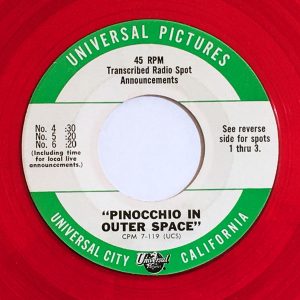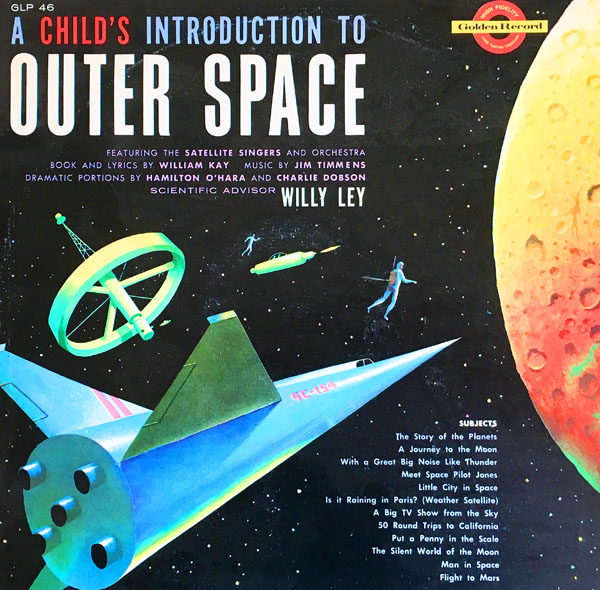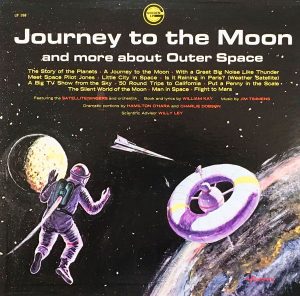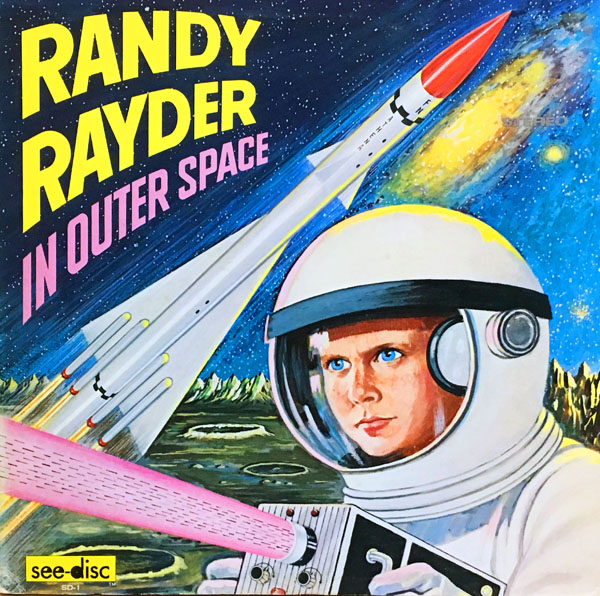Today, Paul Frees and Art Gilmore frantically hawk a spaced-out feature – and we feature other discs with animation ties that epitomize the baby boom era’s obsession with space exploration and sci-fi.

PINOCCHIO IN OUTER SPACE
Transcribed Radio Spot Announcements
Universal Pictures CPM-7-119 (7” 45 RPM LP / Mono)
If Abbott and Costello could go to Mars, and if The Three Stooges could not only go into space but also meet Snow White, was Pinocchio in Outer Space really such a stretch?
 Animated features were at a premium in the sixties, with Disney releasing a classic every seven years or so and producing a new one only every four years or more. Thus, the marketing “hooks” of Pinocchio in Outer Space are clearly that it was “new” rather than a reissue; that it was in color (since color TV sets were not yet widespread in 1965; and that it featured familiar Disney-like characters. Universal saw enough potential to distribute the film, at least to the then-lucrative matinee market.
Animated features were at a premium in the sixties, with Disney releasing a classic every seven years or so and producing a new one only every four years or more. Thus, the marketing “hooks” of Pinocchio in Outer Space are clearly that it was “new” rather than a reissue; that it was in color (since color TV sets were not yet widespread in 1965; and that it featured familiar Disney-like characters. Universal saw enough potential to distribute the film, at least to the then-lucrative matinee market.
Fred Ladd, who brought Astro Boy and Gigantor to the U.S., produced and wrote Pinocchio in Outer Space with Norm Prescott. Filmation Associates was just getting started at the same time, where Prescott was in partnership with Lou Scheimer and Hal Sutherland (their big hit with CBS’ New Adventures of Superman series was a year away). Journey Back to Oz had been briefly brought to the same Belvision Studios in Belgium as Pinocchio for production, but the small operation couldn’t shoulder the burden (more about Oz in this Spin).
Belvision did quite a fine job on Pinocchio, creating consistent, fluid animation throughout with interesting character designs. The premise, strange as it is, somehow manages to hold together despite the film having three distinct styles. To pad the run time, it starts with a five-minute prologue about space travel narrated by the great Norman Rose (he was one of the voices of NBC in the early ‘70s, among hundreds of other projects). After the main title credits, the Pinocchio premise is set up (he was naughty so he’s a puppet again) with three peppy little songs, one called “Goody Good Morning” by Peter Pan Records writer/producer Arthur Korb. After Arnold Stang’s Nurtle the Twurtle arrives, the film shifts into sci-fi and stays there. The whole thing could be disastrous, but it’s quite charming and delightful—it just doesn’t seem that way on paper.
The film used a cast of New York-based actors for the voices–including Minerva Pious as the Blue Fairy’s mother, who was the popular “Mrs. Nussbaum” of radio’s Fred Allen Show; sportscaster Kevin Kennedy as the newscaster; and radio’s “The Shadow” (after Orson Welles), Bret Morrison, who is heard just before the main title and also sings for the Fox.
“Pinocchio in Outer Space” Radio Spots
There was no soundtrack album for Pinocchio in Outer Space, but there remains a transcription disc of radio spots, produced in Hollywood with Paul Frees, Art Gilmore and two young actors. There is only one snippet of dialogue from the film, featuring Peter Lazer as Pinocchio.

A CHILD’S INTRODUCTION TO OUTER SPACE
The Satellite Singers and Orchestra
Scientific Advisor: Willy Ley
Golden Records GLP-46 (12” 33 1/3 RPM LP / Mono)
Reissue: Journey to the Moon (Golden LP-158 / 1964)
Executive Producer: Arthur Shimkin. Book & Lyrics: William Kaye. Composer/Arranger/Conductor: Jim Timmens. Dramatic Portions: Hamilton O’Hara, Charlie Dobson.
Vocalists: Dottie Evans, Bob Harter, Audrey Marsh, Bob Miller.
Subjects/Songs: “The Story of the Planets,” “A Journey to the Moon,” “With a Great Big Noise Like Thunder,” “Meet Space Pilot Jones,” “Little City in Space; Is it Raining In Paris? (Weather Satellite),” “A Big TV Show from the Sky,” “50 Round Trips to California,” “Put a Penny in the Scale,” “The Silent World of the Moon,” “Men in Space,” “Flight to Mars” by Jim Timmens, Bill Kaye, Hamilton O’Hara, Charlie Dobson.
 If little Richie on The Dick Van Dyke Show were asking Rob and Laura Petrie questions about outer space, and then Rob was fumbling comically through the encyclopedia, Buddy and Sally would probably appear at the door with this new album from their pals at Golden Records. Then we would all hear this sort of “hey gang, let’s make this dull stuff kinda fun and modern for the new sixties kids wearin’ their space helmets” through the jaunty tunes and casual-yet-authoritative narration.
If little Richie on The Dick Van Dyke Show were asking Rob and Laura Petrie questions about outer space, and then Rob was fumbling comically through the encyclopedia, Buddy and Sally would probably appear at the door with this new album from their pals at Golden Records. Then we would all hear this sort of “hey gang, let’s make this dull stuff kinda fun and modern for the new sixties kids wearin’ their space helmets” through the jaunty tunes and casual-yet-authoritative narration.
Golden hired many of the best talent from the stage and also from Madison Avenue (Golden songwriter Paul Parnes wrote “Snap Crackle Pop!”),. These songs are like little jingles, very much in the style of what one might hear on AM radio ads in the late ‘50s/early ‘60s.
Willy Ley, the consultant for this album, was one of the “go-to” scientists but for fact and fiction regarding the space program at the time, either as author or featured expert in countless articles and media interviews. Perhaps his highest profile role came when he, Dr. Heinz Haber and especially Dr. Werner Von Braun (of whom Allan Sherman sang in his parody, “Oh, Boy”) worked with animator/writer/director Ward Kimball on the Disneyland TV shows about space exploration. As thoroughly chronicled in the recent biography of Kimball by Todd James Pierce, these shows – Man in Space, Man and the Moon and Mars and Beyond – had an impact on history in that they brought complex ideas and theories to the general public in clear, entertaining ways and actually sparked the U.S. government’s action in the space program, initiating support with Washington official and with the public.
A Child’s Introduction to Outer Space
One of the singers to listen for is Bob Harter, who voiced the lead role in Gulliver’s Travels Beyond the Moon (see this Spin) and played Big Claus on and off camera in the Rankin/Bass feature The Daydreamer (see this Spin).

RANDY RAYDER IN OUTER SPACE
See-Disc (Continental Dynamics) SD-1 (12” 33 1/3 RPM LP / Mono)
Released in 1969. Script: E.A.F. Clarkson. Voices Include: Cecil Roy, Allen Swift.
This is a jolly Flash Gordon/Buck Rogers romp with kids as the heroes. The tone seems more at home with the drive-in movie goers of the late fifties or the Clutch Cargo crowd of the early sixties than the year of the actual moon landing, but it’s super silly fun just the same. It’s reminiscent of Santa Claus Conquers the Martians or a Saturday matinee serial, and it even comes with a keen comic book! Here’s a page:

Randy Rayder in Outer Space
Cecil Roy, one of the voices of Casper the Friendly Ghost, handles the vocal duties for Randy. The entire cast is uncredited, though Allen Swift does a few voices. Others may include Bob McFadden. The album was produced in California but recorded in New York, very much in the classic children’s radio adventure mold.


 GREG EHRBAR is a freelance writer/producer for television, advertising, books, theme parks and stage. Greg has worked on content for such studios as Disney, Warner and Universal, with some of Hollywood’s biggest stars. His numerous books include Mouse Tracks: The Story of Walt Disney Records (with Tim Hollis). Visit
GREG EHRBAR is a freelance writer/producer for television, advertising, books, theme parks and stage. Greg has worked on content for such studios as Disney, Warner and Universal, with some of Hollywood’s biggest stars. His numerous books include Mouse Tracks: The Story of Walt Disney Records (with Tim Hollis). Visit 





















































I first watched the film about 7 years ago, and was pleasantly surprised by how much I enjoyed it.
I started off with low expectations by the title (which probably helped), but enjoyed it in the same spirit that I would watch some of Norm Prescott’s better latter TV cartoon series.
If you’re expecting Disney’s Pinocchio – clearly forget it.
If you’re expecting a more serous version of a Fractured Fairy Tale of Pinocchio, then ok.
Fun trivia: “Pinocchio in Outer Space” uses a few of the same stock pieces that would later be used in “Ren & Stimpy”, such as “Cataclysm” and “Cacodemon” by Maurice Jarre.
And that’s Hecky Krasnow’s Swingin’ Ghosts when the two meet. Used in a few Augie Doggies and at the end of at least one My Three Sons. Jarre, of course, a few years later Dr.Zhivago and came up with his own hit, Lara’s Theme or Somewhere My Love.
I actually have to admit that you’ve peaked my interest here. I only wish that some of this “super silly” stuff was actually out somewhere so that we could check out the films. Hey, if Paul Frees, Cecil Roy or Alan Swift is involved, I’m in.
So… on PINOCCHIO, Fred Ladd was billed as both “Fred Ladd” (as co-producer) and “Fred Laderman” (as screenwriter)? Gosh.
I do fondly recall that Norman Rose narration.
Bret Morrison performed the title character in more episodes of THE SHADOW than any other actor, but has the fewest number of surviving episodes because his run on the show was in the postwar era when radio drama was considered kaput. He moved on to a second voiceover career dubbing foreign films, which proved to be a lifeline to quite a few of his audio contemporaries, some mentioned here as well. Hard as it may be to believe, by the time he participated in this cartoon there were more movies from other countries being released in the US than domestic efforts, thanks to a wide-open distribution system that allowed small players to push such acquisitions to neighborhood theaters and drive-ins.
It’s great to hear that others like this film. It is one of my “guilty” pleasures too, although nothing really to feel guilty about. Some very impressive scenes like Astro the whale and that planet with the giant crabs.
Mister Kitty’s look at the Randy Rayder comic:
http://www.misterkitty.org/extras/stupidcovers/stupidcomics180.html
Clearly, “PINNOCHIO IN OUTER SPACE” was a grand animated feature, way more advanced then Filmation Associates’ 1987 “PINNOCHIO AND THE EMPEROR OF NIGHT”, although I seriously enjoy this feature, the 1965 film that Universal released was a true classic, and Norm Prescott & Lou Scheimer with Hal Sutherland (may they all rest in peace) took Filmation Associates to its highest peak when they made the animated pilot to “FLASH GORDON” in the late 1970s. but “PINNOCHIO IN OUTER SPACE” was a pure 1960s animated film that stayed true to both The Space Age and the Fairytale concept that it was loosely based on. in general, this was an amazing family film for all to enjoy, and while it was no match for Walt Disney’s commercially established version, “PINNOCHIO IN OUTER SPACE” was still a great animated movie, and the animation quality was superior and impressive, especially since it was produced by European animators likely under Norm Prescott’s supervision, it was still an outstanding example of great animation!
While I didn’t catch up with “Pinocchio in Outer Space” until it reached local television, I remember TV ads that focused on the Fox and the beatnik Cat. The portion set on Mars is surprisingly bleak stuff, suggesting the Martians were killed off by the monsters they created. Dead or dying civilizations were very common in live action space flicks, from “Forbidden Planet” down to “Cat-Women On The Moon”. I always suspected these underpopulated planets were a budget decision, even in animation.
Sorry, but the ‘Santa Claus Conquers The Martians’ 45/Read-A-Long Comic has this beat.
I remember first seeing”Pinocchio in Outer Space”at The Laconia Movie Theater in the Bronx,NYC back in
the mid 1960’s.I love it. And I was lucky enough to meet and do an interview with one of the vo performers from
the film..before he left us..Arnold Stang.